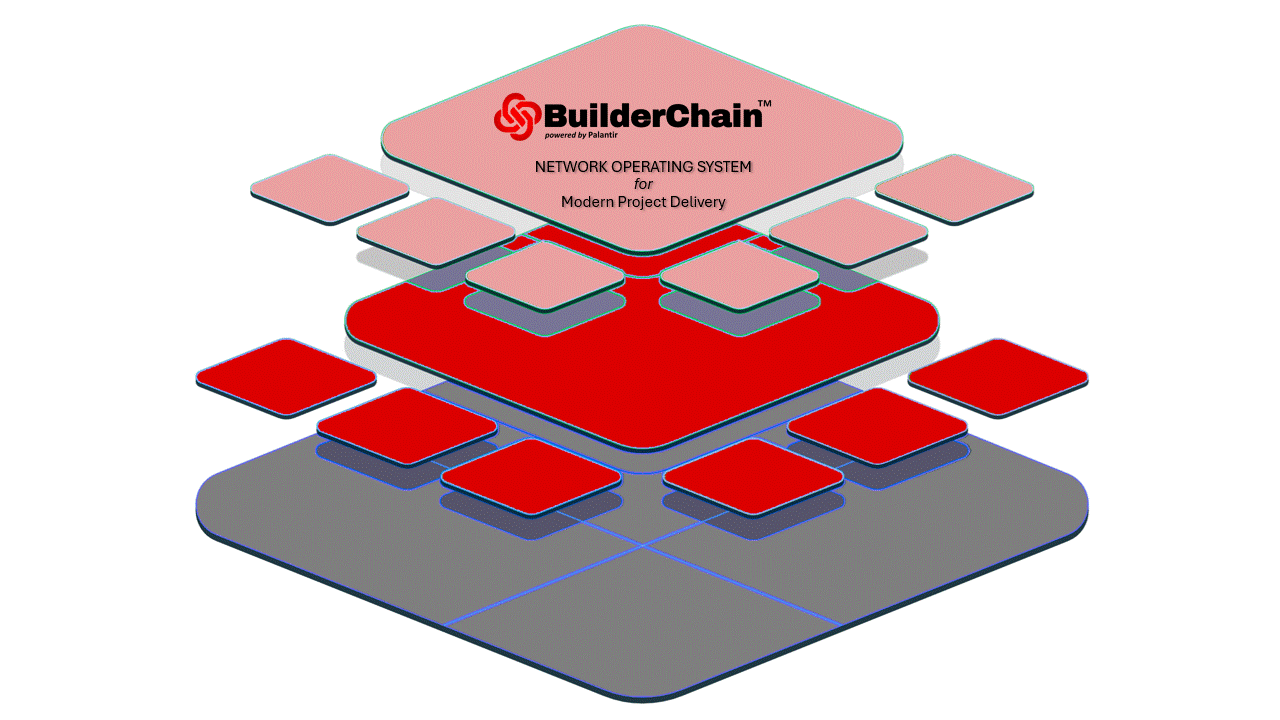
Network Operating System
for the Construction Industry
The concept of a Network Operating System (NOS) as envisioned by Palantir Technologies is a game-changing approach to managing complex, multi-faceted operations, especially in industries like construction. BuilderChain leverages this concept by integrating Palantir’s ontology-based operational environment to optimize construction project operations at a network level.
Unlike traditional systems that focus heavily on project planning, BuilderChain’s NOS empowers real-time, dynamic project operations that adapt and evolve as the project progresses. This shift is crucial in addressing the real-world challenges highlighted in Todd Dazelle’s book *Built to Fail*, which reveals how rigid, isolated systems often set construction projects up for failure.


The Foundation of a Network Operating System
At its core, a Network Operating System (NOS) is designed to manage operations across a connected ecosystem, integrating data, processes, and workflows into a unified platform. BuilderChain’s NOS, powered by Palantir, takes this concept further by introducing an ontology-based operational environment.
Ontology isn’t just about data—it’s about understanding the relationships and context behind every piece of information, allowing for a deeper, more holistic view of operations. By creating this shared framework, BuilderChain enables all project stakeholders—contractors, suppliers, project managers, and regulators—to work within a single, real-time operational environment.

Differentiating Project Operations from Project Planning
One of the key insights from *Built to Fail* is that project planning and project operations are fundamentally different, yet most systems treat them as one and the same. Planning involves creating timelines, allocating resources, and setting milestones. Operations, however, involve adapting to on-the-ground realities, managing changes, and making decisions as new data emerges. BuilderChain’s ontology-based environment is built to handle these operational complexities.
Instead of static plans that often become outdated, BuilderChain dynamically adjusts workflows, schedules, and resource allocations in real-time. When unexpected issues arise—whether it’s a delay in material delivery, a sudden change in weather, or a compliance issue—BuilderChain’s NOS can instantly update the project’s operational model, ensuring that decisions are made with the most current and relevant information.

The Power of a True Network-Level Operation
The book *Built to Fail* exposes the pitfalls of traditional construction management systems that operate in silos. The book advocates for a network-level approach where all participants are connected, informed, and aligned. This is precisely where BuilderChain shines. BuilderChain’s NOS operates at the network level, integrating every organization involved in a construction project into a single, collaborative environment.
By leveraging Palantir’s powerful data integration and ontology capabilities, BuilderChain creates a shared operational framework where data flows seamlessly across organizations. This network-level operation allows for coordinated decision-making, rapid response to changes, and efficient management of resources across multiple projects. The result is fewer delays, reduced waste, and more predictable outcomes—key factors in avoiding the failures Todd Dazelle outlines in his book.

Optimizing Construction Operations with Ontology-Based Intelligence
BuilderChain’s ontology-based environment doesn’t just connect data; it understands the relationships between every piece of information. For instance, the system knows that a delay in one area will impact multiple other tasks, and it can automatically adjust operations to mitigate those effects. This contextual intelligence enables proactive management, allowing construction companies to anticipate problems before they escalate and to optimize operations continually.
This intelligence extends to BuilderChain’s integrated digital rails, such as the digital payment and credentialing systems. Payments are automatically triggered when milestones are met, and credentials are verified in real-time, ensuring that only qualified personnel are engaged. These features create a frictionless operational environment where every participant has the data they need to act quickly and effectively.

The Impact of BuilderChain’s Network Operating System
The ultimate value of BuilderChain’s NOS lies in its ability to drive superior project execution at scale. By shifting the focus from rigid planning to adaptive operations, BuilderChain enables construction companies to navigate complexities and deliver successful outcomes even in challenging conditions. This flexibility is particularly valuable in large-scale projects involving numerous stakeholders, each with their own set of priorities and constraints.
By leveraging a single source of truth—an immutable, distributed ledger—BuilderChain ensures that everyone is working from the same accurate and up-to-date information. This transparency and alignment reduce conflicts, enhance collaboration, and enable faster, better-informed decision-making. The NOS’s ability to unify cross-organizational workflows is not just a technical advantage; it’s a strategic one that positions BuilderChain users to lead in an increasingly competitive industry.

Conclusion: The Future of Construction Management with BuilderChain
BuilderChain’s use of a Network Operating System, powered by Palantir’s ontology-based operational environment, represents the next evolution in construction management. By differentiating between planning and operations and embracing a network-level approach, BuilderChain overcomes the challenges that have long plagued the industry. As Todd Dazelle’s *Built to Fail* demonstrates, true success in construction requires more than just better planning—it requires adaptive, intelligent operations that can thrive in real-world conditions.
With BuilderChain, companies can leverage cutting-edge technology to transform their operations, optimize performance, and consistently deliver projects on time and within budget. The future of construction is here, and it’s powered by the BuilderChain Network.

